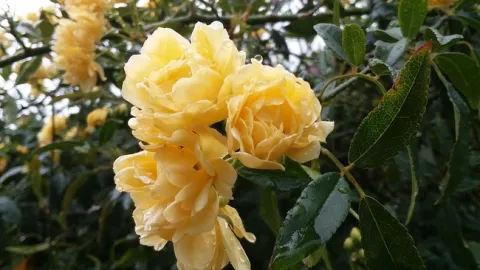
Banksea Rose
By Polly Nelson UCCE Master Gardener
Common Name: Lady Banks Rose
Scientific Name: Rosa Banksiae
Planting Area: Sunset zones 4-24
Size: 20 feet or more if allowed
Bloom Season: Early to late spring
Exposure: Full sun or light shade
Pruning needs: Depends on placement, at least annually
Water needs: Average; do not overwater
Snapshot:
Picture your arbor, fence or bank covered with green foliage and large clusters of yellow or white blossoms in the spring! Originally from China, this climbing rose was named after Dorothea Lady Banks, wife of botanist Sir Joseph Banks. Two varieties include “Lutea” (pictured), with small, scentless double yellow blossoms; and “Alba Plena” with white, violet-scented blossoms. Both have glossy, leathery leaves on stems with a limited number of thorns. Many Rosa Banksiae plants bloom twice, first on last year's post-bloom growth, then on the growth of the current season, which lasts from early to late spring. Blooms attract bees and butterflies.
Water regularly. Irrigation amounts depend on location, season and climate. One cause of yellow leaves can be overwatering (along with insufficient nitrogen or viral/fungal infestation).
Fertilize established plants once at the beginning of the growing season, and once after blooms finish, using a balanced fertilizer, NPK (nitrogen-phosphorus-potassium) or 10-10-10 or 12-12-12. When first planting climbing roses, amend the soil in the planting hole by mixing in compost to increase humus and organic fertilizer to provide the needed nutrients. Choose an organic fertilizer with a NPK ratio of 2-5-2. Mix in a handful of bone meal at planting time to provide phosphorus for healthy root development. Maintain 1-3 inches of mulch around the plant, but away from the trunk.
Prune during the year to remove dead or diseased branches. In winter, remove injured, crossed, spindly branches. Remove woody canes at the base, and trim canes that can no longer provide support. Pruning also helps to maintain the desired shape of the rose bush. Deadhead spent flowers during the bloom season to promote new growth. Fasten new (and old) growth to the trellis, wall or fence with tape or ties.
We are still here!!!
No in-person workshops for now, but you can view workshops on:
Instagram live at slo_mg or visit our You Tube channel
at “San Luis Obispo County UC Master Gardeners”.
Visit our website; https://ucanr.edu/sites/mgslo/
or email us at anrmgslo@ucanr.edu
Our physical offices are closed, but you can still call or email questions:
San Luis Obispo 805-781-5939
Arroyo Grande 805-473-7190
Templeton 805-434-4105

